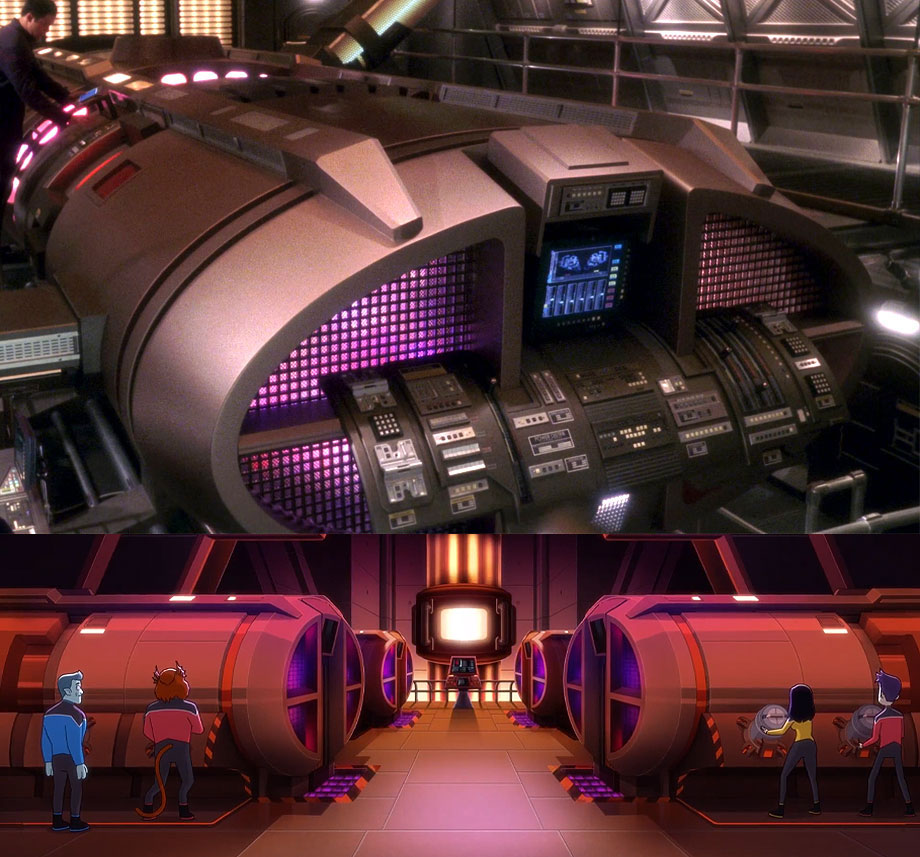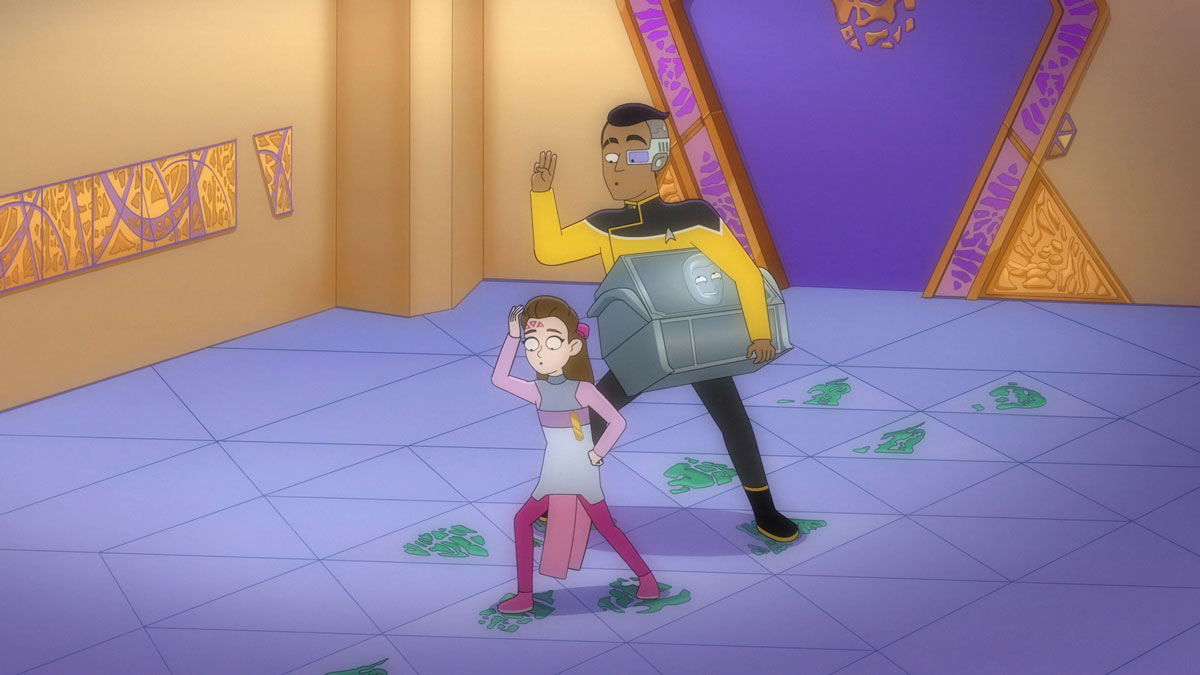Star Trek: Lower Decks is serving up A, B, and C stories in this week’s episode, which explore ideas of teamwork and delegating — wasting no time exploring the show’s slightly new dynamic. “In the Cradle of Vexilon” leans a little too hard into sitcom tropes to be a real winning Star Trek episode for me, but there’s an underlying heart in the Boimler storyline particularly that really works.
The USS Cerritos is assigned to conduct maintenance and repairs to the benevolent supercomputer Vexilon, which maintains a giant ring world known by its current occupants as Corazonia. Captain Freeman (Dawnn Lewis) decides to personally conduct the repairs to the supercomputer… with less than stellar results.

Meanwhile, Lieutenant Boimler (Jack Quaid), with support from T’Lyn (Gabrielle Ruiz) leads his first away team to retrofit one of the planet’s power facilities, and has to learn to trust in his command abilities and put his faith in others. And back on ship, Lieutenants Mariner (Tawny Newsome), Rutherford (Eugene Cordero), and Tendi (Noel Wells) are concerned they’re being hazed by more senior officers by being given even more grunt work.
The Boimler-T’Lyn story is definitely the most interesting of the episode, and one that would not have been possible in prior seasons when the characters were still ensigns — so it’s great to see Lower Decks evolve as the characters advance. It’s been a right of passage for a number of Trek characters to get an episode that’s about them learning to command (like Deanna Troi in “Thine Own Self” or Harry Kim in “Nightingale”), and here it’s Boimler’s turn to learn that he needs his crew… as much as they rely on him to lead.
Discovering that Boimler’s reticence to trust his away team to help (leading him to do all of the work himself) is based not on his belief that they can’t succeed, but that he can’t lead them successfully, is effective — and the presence of T’Lyn really works here and shows why she’s such a great addition to the core character dynamics. Throughout this episode, T’Lyn serves as the straight woman for Boimler’s antics, and passes along some important wisdom at exactly the right moments.
I love it when Lower Decks calls back to itself and continues building out its own mythos, and the experiences Boimler has after his “death” seeing the Black Mountain and the koala build on previous episodes in a fun way.

The hazing story on the Cerritos is appropriately zany, complete with a full-on sprint run through the main visual beats of the Deep Space Nine episode “Move Along Home.” This story juxtaposes quite well with the Boimler story on the surface, because it reminds us that while these characters are starting to take on more leadership roles, the show is still about working in Starfleet’s low ranks, and there’s still a lot of humor to be mined from exploring those kind of power dynamics.
Unfortunately, though, the Captain Freeman story is something of a bust. I really don’t respond well to Lower Decks storylines that live or die based on the characters making an obviously stupid choice for the sole reason of driving the plot and injecting some humor into it. (Freeman deciding to fix Vexilon herself, when she clearly had no idea about the computer’s programming, falls into that category.)

Yes, the Freeman storyline is clearly designed to have thematic similarities to the Boimler plot — Freeman also should be delegating and is choosing not to — but fresh-faced lieutenants get to make those mistakes authentically. When the show decides that the captain does it, for me, the underlying message is lost, and I am just focused on how this feels like an inauthentic and stupid decision by the character.
Lower Decks is better than making its characters dumb to create a source for drama, and episodes that feature that crutch are never as funny, effective, or interesting as those that let our characters be as good as their position and rank requires — while also creating sources of drama for them to react to and be funny in.
Compare the Freeman story this week with Ransom and Mariner’s encounter with the Moopsy in “I Have No Bones Yet I Must Flee.” Last week, those characters faced an antagonist that allowed them to be good at their jobs with all the excitement and humor that the episode’s plot demanded. That Lower Decks succeeds as a Star Trek show, and not just a generic workplace sitcom. Captain Freeman was Michael Scott in The Office today, and I didn’t love that.

TREK TROPE TRIBUTES
- This episode explores a common trope across the series of a character who must get comfortable quickly with commanding others who is not used to being in that situation. Other examples of this include Spock in “The Galileo Seven” and Worf in “Starship Down.”
CANON CONNECTIONS
- The Anomaly Storage Room aboard the Cerritos includes a Vulcan lirpa, the Nomad probe (from “The Changeling”), a Romulan cloaking device (from “The Enterprise Incident”), a Klingon bat’leth, a Betazoid gift box (from “Haven”), a device that seems to function similarly to the Kataan probe (from “The Inner Light”), and the Wadi Chula game (from “Move Along Home”).
- Rutherford speed runs through all the chaps of Chula seen in “Move Along Home,” implying that he makes all the exact same moves as Quark does in moving through the game.
- After Boimler briefly dies, he experiences a vision of the Black Mountain referenced by Shax after his return from the dead in “We’ll Always Have Tom Paris,” and the universe-defining koala that has shown up in multiple episodes of Lower Decks.

OBSERVATION LOUNGE
- The extra-dimensional Koala speaks backwards to Boimler — reversed, the Koala says “It is not your time, Bradward Boimler!”
- The black-and-white zigzag floor of the Black Mountain chalet (and the backwards-speaking Koala) is a clear homage to the Red Room in Twin Peaks.
- This is the fourth episode of Lower Decks not to feature an opening teaser, making Lower Decks the series with the highest number of teaser-less episodes.
- Corazonia is Star Trek’s first “ringworld” planet.
- There is some fun world-building in this episode, with the idea that the Corazonians settled on this ring planet but were not the species who constructed it.

- The power cores on Corazonia, installed during Starfleet’s first contact with the planet, are similar in design to the warp core aboard Enterprise NX-01.
- Last week we learned that Billups had a pet dragon growing up called Fiddlesticks, and now we discover he has a pet ferret called Lancelot. Lancelot (who normally sleeps in his snuggle tower in Billups’s quarters) apparently does not much like Rutherford, and the feeling is mutual.
- “Everything that has ever occurred is science stuff” will surely delight all STEM professionals.
- Orions deal with hazing through blindfolded saber fights.
- “Tellarite slop jazz.” That’s all.

“In the Cradle of Vexilon” is a pretty average episode of Lower Decks because of its reliance on sitcom tropes — but it shows a lot of promise and potential for new story ideas that our main characters’ recent promotions have made possible. The show is at its most successful when it is growing and evolving alongside these characters, and this tale edges close to successfully doing that.
![]()
September 21 on Paramount+, Star Trek: Lower Decks heads to Orion with “Something Borrowed, Something Green.”
